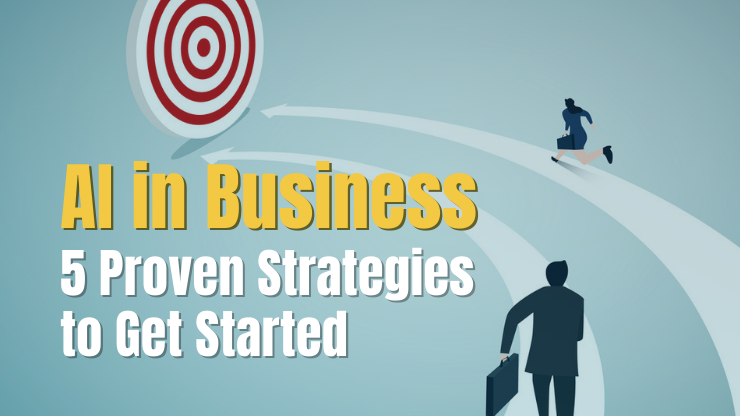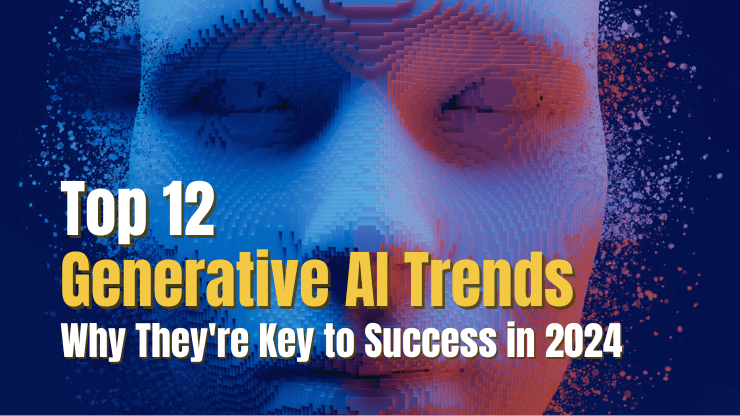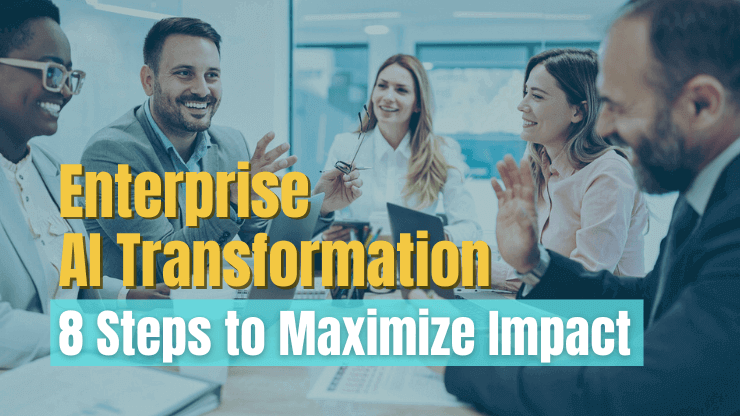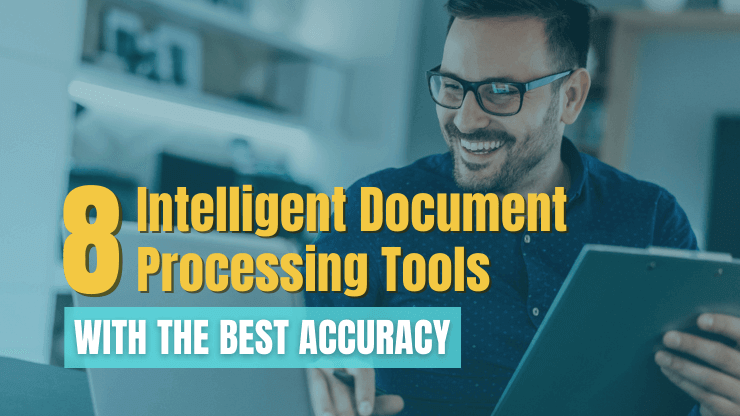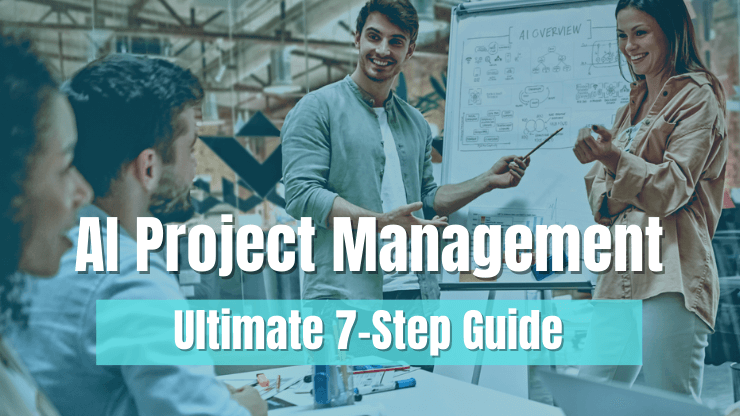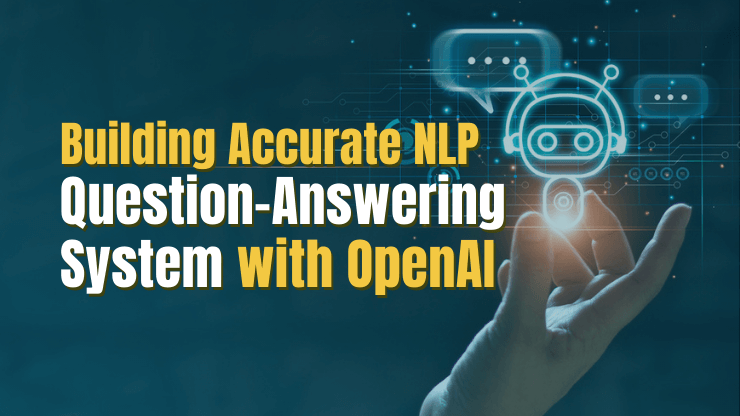Artificial Intelligence (AI) is revolutionizing the way businesses operate by providing a game-changing competitive advantage and driving impressive cost savings. However, as the AI Business Survey shows, the adoption of AI comes with many challenges such as:
- Identifying the right business opportunities
- Developing a plan of action
- Collecting and leveraging data
- Implementing AI solutions to achieve maximum ROI
In this article, we will outline 5 proven strategies for getting started with AI in business. Whether you're just starting to explore the potential of AI or you're looking to expand your existing AI capabilities, this article will provide you with the information and insights you need to make informed decisions about integrating AI into your business.
AI in business
Artificial Intelligence (AI) refers to the use of computer systems to perform tasks that typically require human intelligence, such as speech recognition, visual perception, decision-making, and language translation. AI relies on various technologies, including machine learning, natural language processing (NLP), computer vision, and robotics.
Machine learning, in particular, enables AI to learn and improve from data without being explicitly programmed. Deep learning, a subset of machine learning that uses neural networks to simulate the human brain, has achieved impressive results in image and speech recognition, NLP, and other domains.
AI has become increasingly prevalent in many industries, including healthcare, retail, and transportation, as businesses seek to improve efficiency, decision-making, and customer experience. As a result, AI has emerged as a key driver of innovation and growth in the digital economy.
AI for business - Common use cases
There are many use cases for artificial intelligence in business, and organizations across industries have been leveraging this technology to improve efficiency, reduce costs, and drive innovation. A few of the most common use cases include:
- Marketing and sales: AI can help business leaders improve their marketing and sales strategies by analyzing customer data, predicting consumer behavior, and providing personalized recommendations to consumers.
- Invoice processing: AI-powered software can automatically extract relevant information from invoices, reducing the need for manual data entry and streamlining the billing process.
- Contract analysis: AI can be used to analyze legal contracts and extract important clauses and terms, reducing the human resources needed for manual contract review.
- Customer service: AI-powered chatbots and virtual assistants can help businesses provide quick and efficient customer support, respond to customer requests, handle inquiries, and automate routine tasks that would otherwise be done by human workers.
- Predictive maintenance: AI can use predictive analytics to predict equipment failures and maintenance needs, reducing downtime and costs associated with equipment breakdowns.
- Fraud detection: AI algorithms can analyze large datasets to detect fraudulent activities and prevent financial losses.
- Supply chain optimization: Incorporating AI into supply chain management can help teams to predict demand, optimize inventory levels, and improve shipping and delivery processes.
- Cybersecurity: AI can be used to detect and prevent cybersecurity threats by analyzing network traffic, identifying potential threats, and responding to attacks in real-time.
- Process automation: Teams can use off the shelf tools or build their own custom AI to help streamline a specific business process or even automate their business operations holistically.
Read More: 7 Proven Ways SaaS Startups Can Leverage GPT3 OpenAI API
Challenges in adopting artificial intelligence for business
Adopting this emerging business technology can bring numerous benefits, including increased efficiency, improved decision-making, and reduced operational costs. However, there are several challenges that must be considered before implementing AI:
- Project planning: It’s not simply the dollar figure required that can be the challenge for many businesses; it can also be difficult to simply put together an appropriate budget in the first place, as there are many unknowns when it comes to using advanced technologies like AI. This inability to properly scope out a project and allocate resources can make it difficult for businesses to commit to AI projects.
- Unfamiliarity with AI: AI is a new technology. Even businesses who have strong technical talent can struggle to put together a successful AI strategy. A lack of knowledge about AI, machine learning, or even big data can create confusion and uncertainty when planning and implementing AI projects.
- Talent: Attracting and retaining skilled technology oriented professionals who have expertise in AI can be a significant challenge for many businesses. AI requires specialized skills, and the competition for qualified professionals is fierce. Businesses may struggle to find and retain the right talent to implement and maintain their AI systems.
- Security: As with any technology, AI systems are vulnerable to cyber attacks, data leaks, and other security breaches. The potential consequences of a security breach can be severe, including financial losses, reputational damage, and legal liability.
- Compliance: AI systems must comply with various regulations and ethical considerations. Failure to comply can result in legal penalties, damage to the company's reputation, and potential harm to customers or users.
5 strategies for successful AI implementation

To help mitigate many of the challenges we’ve just looked at, businesses must carefully plan and execute their AI implementation strategies.
In this section, we will help you do just that. Let’s start by looking at how you can best assess your business and find opportunities to integrate AI.
Identify opportunities
When considering implementing AI in your business, it's important to identify opportunities that align with your business goals and provide maximum value. This process should include assessing your team’s readiness for AI development work, identifying specific opportunities to use these emerging technologies, and developing a vision and strategy for your AI work.
Assessing readiness: evaluate your business's ability to adopt AI by considering factors such as training data availability, existing technology infrastructure, ability to meet regulatory compliance requirements, and availability of financial and people resources. This evaluation will help you determine whether your business is ready to move forward with AI implementation or not.
Identifying opportunities: define your business goals and analyze your data to identify potential areas where AI can help you achieve those goals. This can involve reviewing both existing and potential data sources to identify patterns and insights that could inform an AI strategy.
Developing a vision and strategy: create a roadmap for implementing AI that aligns with your business goals and objectives. This may involve partnering with AI experts, vendors, and consultants to explore potential use cases and assess the feasibility of implementing AI in your business.
PRO TIP: Data is the foundation of AI and machine learning algorithms. AI systems need large amounts of high-quality data to learn, improve accuracy, and make informed decisions. If you’re developing your own AI model, high quality training data will be essential to the success of your project. Work with a qualified data scientist or data analyst to assess the quality of your data.
Looking for data engineers to augment your in-house team with expertise, greater capacity and speed? Our data engineering company can help you.
Develop a plan of action
With some business opportunities identified, and perhaps even a general AI strategy in place, you need to develop a specific plan of action for your first AI project. Developing a clear plan of action is crucial for successfully implementing AI in a business. To do so, there are several key best practices to follow:
- Determine data needs: Identify the types of data required to build and train your AI models. This could include data from internal systems, customer interactions, or external sources. Data is essential for AI success, so it's important to ensure that you have the right data to achieve your goals.
- Assess existing resources: Evaluate existing infrastructure, talent, and processes to identify any gaps or areas of improvement. This will help you determine what resources and expertise you need to bring in to successfully implement AI.
- Prioritize initiatives: Once you have identified potential AI use cases, prioritize the most valuable or feasible ones to pursue first. This will help you achieve the greatest impact with your AI implementation.
- Set timelines and milestones: Establish clear timelines and milestones for each initiative, with specific goals and outcomes defined along the way. This will help you stay on track and ensure that you are making progress towards achieving your specific goals.
- Create a governance framework: Develop a framework for managing and monitoring AI initiatives, including data security and ethical considerations. This will help you ensure that your AI implementation is aligned with best practices and complies with any regulations or ethical considerations.
PRO TIP: Engage with stakeholders from across the organization when developing your AI plan of action. This will help ensure that you are addressing the needs and goals of all relevant departments and functions, and increase buy-in and support for the project. It can also uncover additional opportunities and use cases that may have been overlooked by a single team or department.

Collect and clean the data
Collecting and cleaning your data is a crucial aspect of successful AI implementation. The more data you have, the better your AI models will perform. But not all data is created equally. To power AI applications, you need high-quality, relevant, and diverse data.
Think about where you will source your data. Will it require purchasing a license, data scraping publicly available websites, or will all assets be gathered from internal sources? There are many options to consider, including:
- Past data: Often AI capabilities will be built on top of an already existing product, which means you may have data that’s been collected by your product that you wish to use. All you would need to do in this case is organize and make it machine learning friendly (data cleansing).
- Manual data collection: Hiring data labelers and having them manually label datasets. This is often a costly process and can take a long time.
- Automated data collection: Using automated tools and scripts to scrape data from websites and other sources. This can be less expensive than manual data collection, but the quality of the data may not be as high.
- Purchased datasets: Buying datasets from third-party data providers can be a cost-effective way to get large amounts of data quickly, but it may require additional work to clean the data of any irrelevant or incorrect information.
- Generative models: Generative models are a type of AI algorithm that can learn the underlying structure of a given dataset and can generate new data based off of what it learns. The generated data can then be used to augment the original dataset for the AI project.
After you’ve collected your data, you will need to clean it to remove any irrelevant or redundant information from the data so it is suitable for use in the project. This is a critical step to ensure that the model is able to achieve the desired results.
Implement AI solutions
When implementing your AI solution, you have many tools to choose from. When selecting an AI tool, consider factors such as ease of use, integration with existing systems, and cost. Here are some popular options to consider:
- OpenAI: Provides powerful AI language models, including the famous GPT series, for natural language processing and generation.
- Amazon SageMaker: A managed service that provides developers and data scientists with the tools to build, train, and deploy machine learning models quickly and easily on Amazon Web Services.
- Google Cloud AI Platform: A suite of AI tools that enable users to build, test, and deploy machine learning models on Google Cloud. Includes pre-built models, custom training options, and integration with popular frameworks.
- H2O.ai: An open-source platform for building and deploying AI and machine learning models, with a focus on data visualization and interpretability.
- DataRobot: An automated machine learning platform that allows users to build and deploy machine learning models quickly and easily.
These tools offer a range of capabilities such as natural language processing, machine learning, and computer vision. Furthermore, each tool will require a different set of technical skills. Take into account the skills and experience level of your developers, data professionals, and program leads before selecting a tool.
PRO TIP: It’s important to remember that successful AI implementation is an ongoing process. Regularly evaluating the effectiveness of your AI solutions, collecting feedback from users, and continuously refining your approach will help ensure that you're getting the most out of your investment in AI.
Read More: 7 Proven Ways SaaS Startups Can Leverage GPT3 OpenAI API
Measure the ROI of your AI investments
Measuring the return on investment (ROI) of artificial intelligence (AI) initiatives can be a complex process. In fact, many organizations make three primary mistakes:
- Not considering the potential errors in the AI models and required pivots. AI models are not infallible. They require continual monitoring and adjustment. Failing to account for the potential for errors can lead to overestimating the ROI of AI initiatives.
- Computing ROI based on a single point in time, rather than measuring its performance on a continuing basis. AI is not a one-time investment but rather a continual process of improvement and optimization. Failing to measure the ROI of AI initiatives over an extended period can lead to underestimating or overlooking the long-term value of AI investments.
- Treating each AI project in isolation, rather than viewing them as part of a portfolio of investments. AI is not a single solution to a problem but rather a collection of solutions that work together to drive business outcomes. Failing to consider the interconnectedness of AI initiatives can lead to misaligned priorities and missed opportunities to maximize ROI.
To accurately measure the ROI of AI initiatives, organizations need to take a holistic approach that considers both hard and soft investments and returns. Let’s break down what you should take into account as far as investments go:
Hard Investments
Hard investments in AI refer to the actual financial costs associated with building and developing an AI project. When measuring the ROI of AI investments, businesses should consider the following:
- High-performance computing infrastructure: Deep learning models often require a lot of computational power to train and run effectively, so a company may need to invest in powerful hardware and cloud computing services to support their AI development efforts.
- Specialized software: Developing AI models may require specialized software tools and libraries that are not typically used in other areas of the business. A company may need to purchase or license these tools to support their AI initiatives.
- Skilled talent: AI development requires highly skilled professionals such as data scientists, machine learning engineers, and AI architects. Hiring or contracting with such talent may require significant financial investment.
Soft Investments
Soft investments refer to the investments made that are not as easy to calculate in terms of a specific dollar figure. While it’s often harder to measure soft investments, it’s important to take them into account in whatever way you can when conducting an ROI analysis. Consider soft investments such as:
- Data management: High-quality data is critical to the success of AI models, so investing in data-specific business processes and tools such as data cleaning and data augmentation can be considered a soft investment.
- Training and education: Investing in training programs and educational resources for employees can help build an AI-literate workforce capable of supporting the company's AI initiatives.
- Experimentation and exploration: AI is a rapidly evolving field, and companies may need to experiment with new tools and techniques to stay ahead of the competition. Investing in experimentation and exploration is a soft investment that can help a company stay innovative in their approach to AI.
- Change management: AI projects often require significant changes to an organization's existing workflows, business functions, and processes. Investing in change management can help to ensure that these changes are implemented smoothly, and that employees are trained and prepared for the new AI tools and workflows.
Now, think about how you can measure your return on investment. Generally, this can be broken down into hard and soft returns:
Hard Returns
Hard returns from AI investments are the financial benefits that companies can expect from the project. When measuring the ROI of AI investments, businesses should consider the following:
- Time savings: Automated intelligence can reduce the time needed to process repetitive manual and cognitive tasks.
- Productivity increase: Assisted intelligence can enhance human decision-making, resulting in an increase in employee productivity.
- Cost savings: Automation can reduce the number of human jobs needed to perform the same amount of work, which can lower costs.
- Revenue increase: Assisted and augmented intelligence can provide new services that increase both the number of customers and their willingness to pay more for those services.
Soft Returns
Soft returns from AI investments are the intangible benefits that companies can expect from the project. These returns can include:
- Improved customer experience: Implementing AI in your marketing, sales, and post-sales touch points with customers can provide the ability to understand customer requests and respond to them more quickly, use data analytics to analyze customer behavior, or simply elevate the customer’s experience on your website. Regardless of the exact implementation, many use cases of AI will improve customer experience long term and give you a competitive edge.
- Increased operational efficiency: AI can automate repetitive tasks, reducing the workload for employees and improving overall efficiency. This can result in cost savings, increased productivity, and improved accuracy.
- Enhanced decision-making: AI can be used to process vast amounts of data, identify patterns, and make predictions, providing decision-makers with valuable insights. This can lead to better-informed decisions, more effective strategies, and ultimately, improved business performance.
- Better risk management: AI can be used to identify potential risks and threats to the business, such as fraud or cybersecurity threats. This can enable businesses to proactively take steps to mitigate risks and avoid costly incidents.
It’s important to not only identify the returns on your investment in AI but to try to quantify them as specifically as possible. For example, instead of simply identifying that your AI project has led to greater operational efficiency, identify the specific processes that have become more efficient and measure the same savings.
Conclusion
Implementing AI initiatives within a business can be a complex process, but it can provide many benefits if done thoughtfully. To achieve successful AI implementation, businesses must carefully assess their readiness, identify the most lucrative opportunities, and ultimately measure the ROI of their AI investments with a strategy of continuous improvement.
By following the strategies outlined in this article, businesses can leverage AI to achieve their goals and stay competitive in today's rapidly evolving digital landscape.
If you're looking for help developing an AI application, check our AI development services. We can help you leverage the power of AI models to build a market-ready product that stands out from the competition or increase efficiency and boost productivity with a custom AI-powered application.

